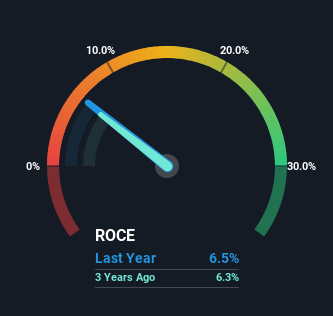L.B. Foster (NASDAQ:FSTR) Will Be Hoping To Turn Its Returns On Capital Around
If we're looking to avoid a business that is in decline, what are the trends that can warn us ahead of time? Businesses in decline often have two underlying trends, firstly, a declining return on capital employed (ROCE) and a declining base of capital employed. This combination can tell you that not only is the company investing less, it's earning less on what it does invest. So after we looked into L.B. Foster (NASDAQ:FSTR), the trends above didn't look too great.
What Is Return On Capital Employed (ROCE)?
Just to clarify if you're unsure, ROCE is a metric for evaluating how much pre-tax income (in percentage terms) a company earns on the capital invested in its business. The formula for this calculation on L.B. Foster is:
Return on Capital Employed = Earnings Before Interest and Tax (EBIT) ÷ (Total Assets - Current Liabilities)
0.065 = US$15m ÷ (US$335m - US$96m) (Based on the trailing twelve months to September 2023).
So, L.B. Foster has an ROCE of 6.5%. Ultimately, that's a low return and it under-performs the Machinery industry average of 12%.
Check out our latest analysis for L.B. Foster
Above you can see how the current ROCE for L.B. Foster compares to its prior returns on capital, but there's only so much you can tell from the past. If you'd like, you can check out the forecasts from the analysts covering L.B. Foster here for free.
The Trend Of ROCE
We are a bit worried about the trend of returns on capital at L.B. Foster. To be more specific, the ROCE was 8.5% five years ago, but since then it has dropped noticeably. And on the capital employed front, the business is utilizing roughly the same amount of capital as it was back then. Companies that exhibit these attributes tend to not be shrinking, but they can be mature and facing pressure on their margins from competition. If these trends continue, we wouldn't expect L.B. Foster to turn into a multi-bagger.
The Bottom Line On L.B. Foster's ROCE
In summary, it's unfortunate that L.B. Foster is generating lower returns from the same amount of capital. Investors must expect better things on the horizon though because the stock has risen 33% in the last five years. Either way, we aren't huge fans of the current trends and so with that we think you might find better investments elsewhere.
If you're still interested in L.B. Foster it's worth checking out our FREE intrinsic value approximation to see if it's trading at an attractive price in other respects.
For those who like to invest in solid companies, check out this free list of companies with solid balance sheets and high returns on equity.
Have feedback on this article? Concerned about the content? Get in touch with us directly. Alternatively, email editorial-team (at) simplywallst.com.
This article by Simply Wall St is general in nature. We provide commentary based on historical data and analyst forecasts only using an unbiased methodology and our articles are not intended to be financial advice. It does not constitute a recommendation to buy or sell any stock, and does not take account of your objectives, or your financial situation. We aim to bring you long-term focused analysis driven by fundamental data. Note that our analysis may not factor in the latest price-sensitive company announcements or qualitative material. Simply Wall St has no position in any stocks mentioned.

